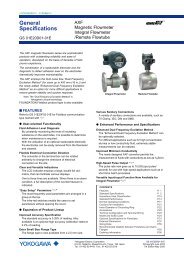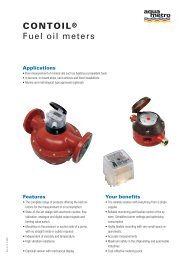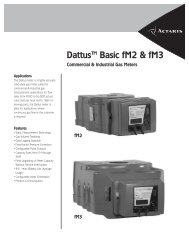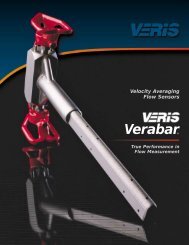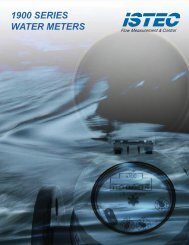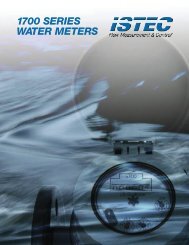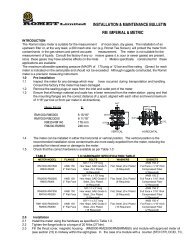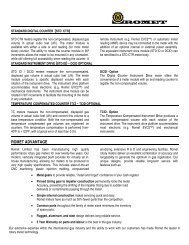User's Manual AXF Magnetic Flowmeter Integral ... - Yokogawa
User's Manual AXF Magnetic Flowmeter Integral ... - Yokogawa
User's Manual AXF Magnetic Flowmeter Integral ... - Yokogawa
Create successful ePaper yourself
Turn your PDF publications into a flip-book with our unique Google optimized e-Paper software.
4.2 Wiring the Remote<br />
Flowtube<br />
This section describes the wiring of the remote<br />
flowtube only. For information relating to the wiring of<br />
the converter, refer to the user’s manual of the<br />
<strong>AXF</strong>A11 <strong>Magnetic</strong> <strong>Flowmeter</strong> Remote Converter (IM<br />
01E20C01-01E) or the <strong>AXF</strong>A14 <strong>Magnetic</strong> <strong>Flowmeter</strong><br />
Remote Converter (IM 01E20C02-01E).<br />
WARNING<br />
The wiring of the magnetic flowmeter must be<br />
performed by expert engineer or skilled personnel.<br />
No operator shall be permitted to perform<br />
procedures relating to wiring.<br />
CAUTION<br />
Once all wiring is complete, check the connections<br />
before applying power to the instrument.<br />
Improper arrangements or wiring may cause a<br />
unit malfunction or damage.<br />
4.2.1 Wiring Precautions<br />
Be sure to observe the following precautions when<br />
wiring:<br />
CAUTION<br />
• In cases where the ambient temperature<br />
exceeds 50°C (122°F), use external heatresistant<br />
wiring with a maximum allowable<br />
temperature of 70°C (158°F) or above.<br />
• Do not connect cables outdoors in wet weather<br />
in order to prevent damage from condensation<br />
and to protect the insulation, e.g. inside the<br />
terminal box of the flowtube.<br />
• Do not splice the cable between the flowtube<br />
terminal and the converter if it is too short.<br />
Replace the short cable with a cable that is the<br />
appropriate length.<br />
• All the cable ends must be provided with round<br />
crimp-on terminals and be securely wired.<br />
• The signal cables must be routed in separate<br />
steel conduit tubes 16 (JIS C 8305) or flexible<br />
conduit tubes 15 (JIS C 8309).<br />
• Keep conduits or flexible tubes watertight using<br />
sealing tape.<br />
4. WIRING<br />
• Ground the remote flowtube and the converter<br />
separately.<br />
• Cover each shield of the signal cable with vinyl<br />
tube or vinyl tape to avoid contact between two<br />
shields or between a shield and a case.<br />
• When waterproof glands or union equipped<br />
waterproof glands are used, avoid tightening<br />
the glands with an excessive torque.<br />
• Be sure to turn the power off before opening<br />
the terminal box cover.<br />
• Before turning the power on, tighten the<br />
terminal box cover securely.<br />
• The terminal box cover of size 2.5 mm to 1000<br />
mm is locked by the special screw. In case of<br />
opening the terminal box cover, use the hexagonal<br />
wrench attached. For handling the<br />
locking screw, refer to Figure 4.2.8.<br />
• Be sure to lock the cover of size 2.5 mm to<br />
1000 mm by the special screw using the<br />
hexagonal wrench attached after installing the<br />
cover. For handling the locking screw, refer to<br />
Figure 4.2.20.<br />
• Explosion protected types must be wired in<br />
accordance with specific requirement (and, in<br />
certain countries, legal regulations) in order to<br />
preserve the effectiveness of their explosion<br />
protected features.<br />
• When submersible type or optional code DHC<br />
is selected, waterproof glands, signal and<br />
excitation cables are attached.<br />
In order to preserve the effectiveness of<br />
waterproof features, the terminal box cover and<br />
waterproof grounds must not be detached from<br />
flowmeter.<br />
4-8<br />
IM 01E20D01-01E






